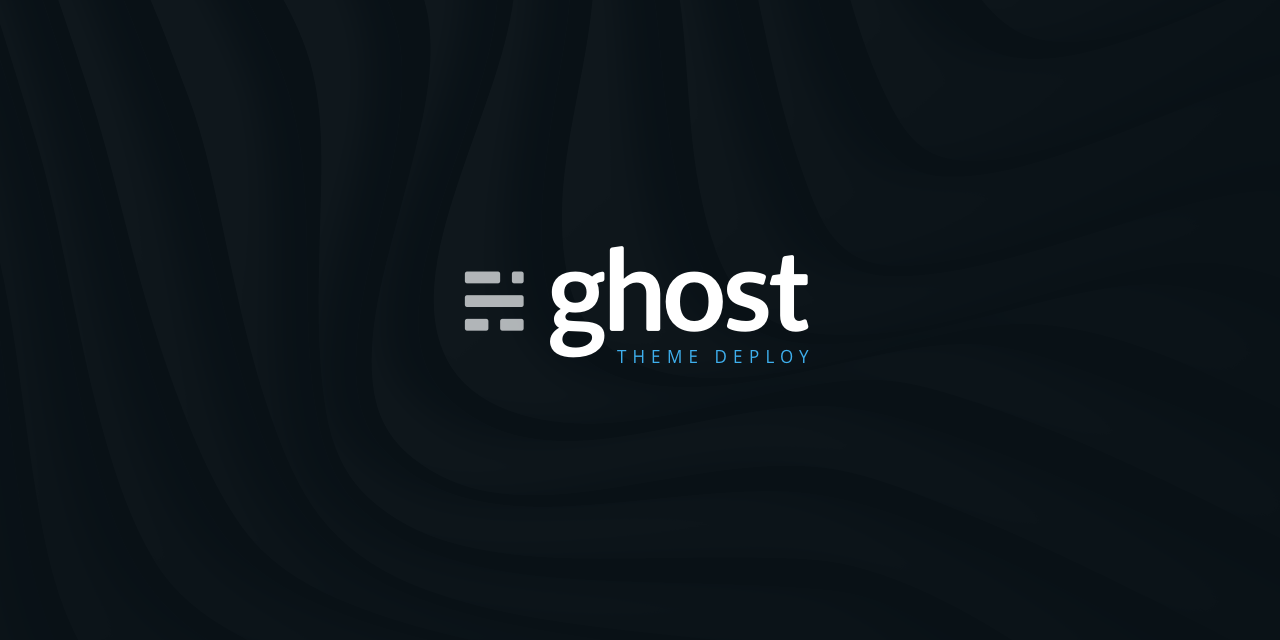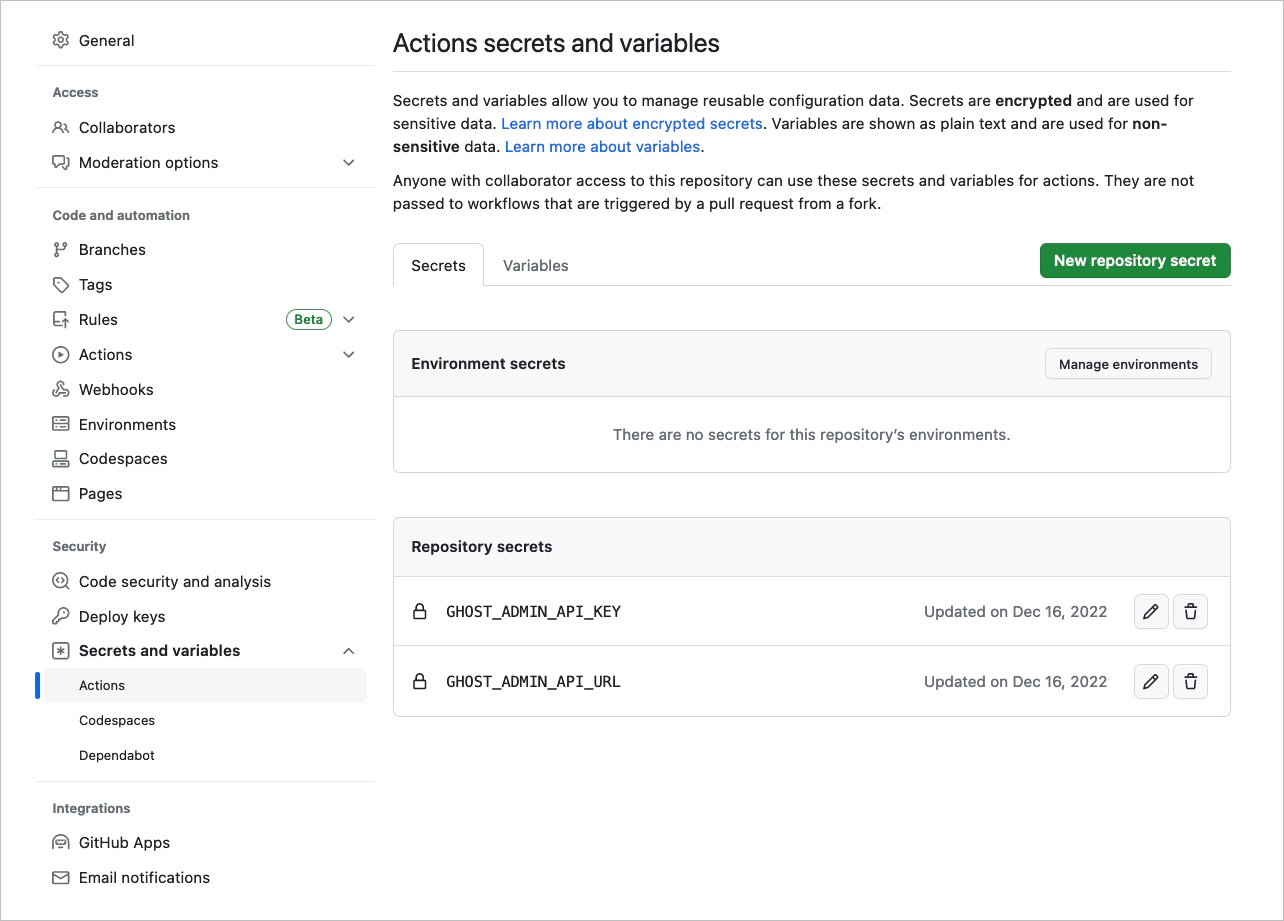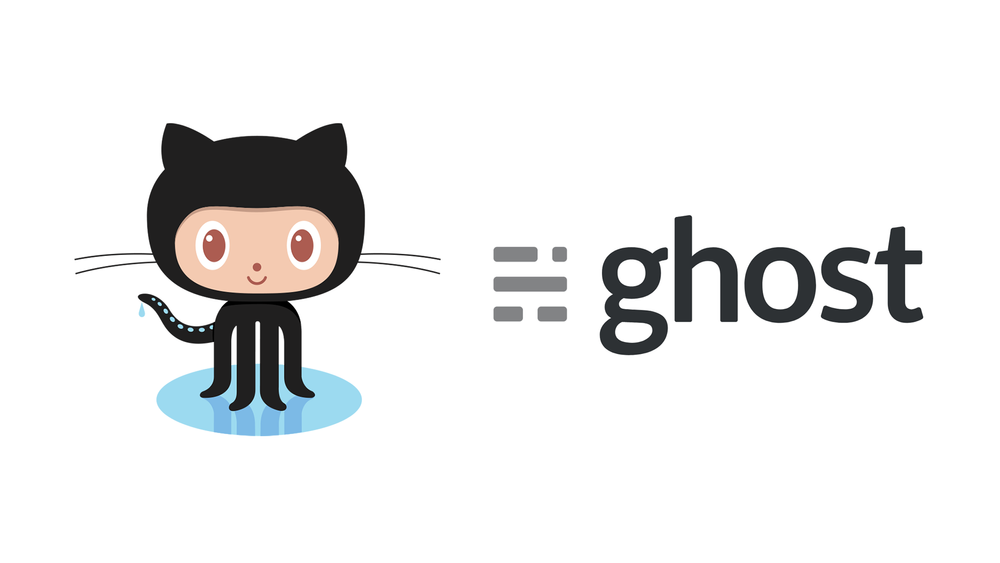Ghost is an excellent platform for contemporary publishing, and it becomes an even more potent tool for version control and content automation when combined with GitHub. I'll show you how to integrate Ghost with GitHub in this tutorial, which includes screenshots and samples from my setup.
Table of Contents
- Why Integrate Ghost with GitHub?
- Prerequisites
- Prepare Your GitHub Repository
- Configure GitHub Actions integration
- Create a Workflow File
- Test and Verify the Workflow
Why Integrate Ghost with GitHub?
By linking Ghost to GitHub, you can:
- Control of Versions Your Content: Monitor modifications and undo if necessary.
- Collaborate Efficiently: Make use of GitHub's extensive collaboration tools when working with your team.
- Automate Publishing: Easily sync your material between Ghost and GitHub.


Let’s get started!
Prerequisites
Before you begin, make sure you have:
- A running instance of Ghost (either self-hosted or via Ghost Pro).
- A GitHub account that you may use to manage your content.
- Basic familiarity with command-line tools and Git.
Prepare Your GitHub Repository
- Create a Repository
- Go to your GitHub account and create a new repository.
- Name it something descriptive, like
ghost-content.
- Set Up Branches
- Use
mainas the default branch for live content. - Optionally, create a
draftsbranch for staging unfinished posts.
- Clone the Repository Locally
Run the following commands:
git clone https://github.com/your-username/ghost-content.git
cd ghost-content
Configure GitHub Actions integration
- Access the Integrations Panel
- Log in to your Ghost admin panel.
- Navigate to Settings > Integrations.
- Create a New Custom Integration
- Click Add Custom Integration and name it
GitHub Actions.
- Click Add Custom Integration and name it

Set your Ghost integration credentials in GitHub
Next, copy and paste your integration details into your GitHub repository’s secrets. You can find these under Settings → Secrets and variables → Actions.

Create a secret named GHOST_ADMIN_API_URL using the API URL from your custom integration and another secret named GHOST_ADMIN_API_KEY using the Admin API Key from the same integration.
Create a Workflow File
Add a workflow file to automate the deployment:
- File Path:
.github/workflows/deploy-theme.yml
name: Deploy Ghost Theme
on:
push:
branches:
- main
jobs:
deploy:
runs-on: ubuntu-latest
steps:
- name: Checkout Repository
uses: actions/checkout@v3
- name: Deploy Theme to Ghost
uses: TryGhost/action-deploy-theme@v1.6.0
with:
api-url: ${{ secrets.GHOST_ADMIN_API_URL }}
api-key: ${{ secrets.GHOST_ADMIN_API_KEY }}
Below my workflow, where I have also added the needed steps to copy and deploy the theme in my Raspberry PI:
name: Deploy Theme
on:
push:
branches:
- master
- main
paths-ignore:
- 'Ansible/**'
- '.github/workflows/iac-webserver.yml'
- '.github/workflows/os-hardening.yml'
- '.github/workflows/os-upgrade.yml'
- '.github/workflows/ssh-hardening.yml'
- '.github/workflows/nginx-hardening.yml'
- '.github/workflows/deploy.yml'
- '.github/workflows/backupghost.yml'
- '.github/workflows/deploy_nginx.yml'
- 'docker-compose.yml'
- 'docker-entrypoint.sh'
- 'Dockerfile'
jobs:
deploy:
runs-on: ubuntu-22.04
steps:
- uses: actions/checkout@v4
- name: Remove unwanted files and folders
run: |
rm docker-compose.yml
rm renovate.json
- name: Deploy Ghost Theme
uses: TryGhost/action-deploy-theme@v1.6.6
with:
api-url: ${{ secrets.GHOST_ADMIN_API_URL }}
api-key: ${{ secrets.GHOST_ADMIN_API_KEY }}
exclude: 'Ansible/**'
- name: Copy arun.zip via SCP
uses: appleboy/scp-action@v0.1.7
with:
host: ${{ secrets.RASPBERRY_PI_HOST }}
username: ${{ secrets.RASPBERRY_PI_USERNAME }}
key: ${{ secrets.SSH_PRIVATE_KEY }}
port: ${{ secrets.RASPBERRY_PI_SSH_PORT }}
source: "arun.zip"
target: "/home/marco/ghost-blog/"
env:
SSH_KEY: ${{ secrets.SSH_PRIVATE_KEY }}
- name: Unzip arun.zip into Docker container
uses: appleboy/ssh-action@master
with:
host: ${{ secrets.RASPBERRY_PI_HOST }}
username: ${{ secrets.RASPBERRY_PI_USERNAME }}
key: ${{ secrets.SSH_PRIVATE_KEY }}
port: ${{ secrets.RASPBERRY_PI_SSH_PORT }}
script: | (script)
- name: Restart Ghost Container on Raspberry Pi
uses: appleboy/ssh-action@master
with:
host: ${{ secrets.RASPBERRY_PI_HOST }}
username: ${{ secrets.RASPBERRY_PI_USERNAME }}
key: ${{ secrets.SSH_PRIVATE_KEY }}
port: ${{ secrets.RASPBERRY_PI_SSH_PORT }}
script: |
docker restart ghost-blog_ghost_1
Test and Verify The Workflow
- Push changes to the
mainbranch of your theme repository. - Go to the Actions tab in your GitHub repository to monitor the workflow execution.
- Verify that the theme is successfully deployed to your Ghost instance.

Bonus Tip: Version Control Your Theme
This process guarantees version control for your Ghost theme. You can efficiently and effectively roll back updates and track changes!



